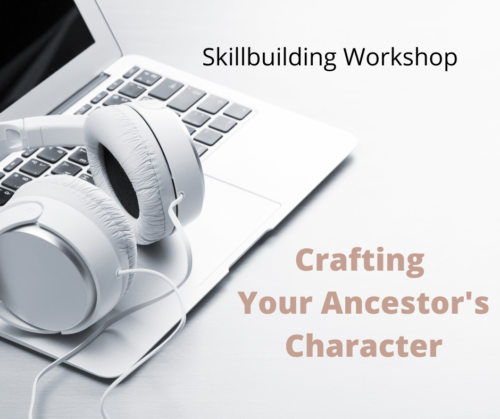How to Reveal Your Ancestor’s Character
1 thought on “How to Reveal Your Ancestor’s Character”
Comments are closed.
Related Post

Goals, Motivations and StakesGoals, Motivations and Stakes
You’ve chosen your Protagonist Ancestor, and now it’s time to structure his or her story in a format that will keep your readers entertained and engaged from beginning to end.
Every main character in a story has a goal that is ultimately the heart of the story. A reader stays with a story to see if the main character reach their goal. Your ancestor’s goal is motivated by something in their life, usually in their history, an experience, or event that may of had a substantial impact on them and their actions. In addition, if they didn’t achieve their goal, they fear a loss. It could be an external loss such as in a material item, money or land, or even the loss of life, or it could be internal losses, such as respect or honour.
Before you begin to write your story, it’s important to recognize the goals, motivations and stakes of your ancestor. They are critical to not only understanding them but also in shaping their story.
I love these next three questions because by answering them you not only identify your ancestor’s goals, motivations and stakes but you understand how they relate to each other.
GOAL – WHAT DOES YOUR ANCESTOR WANT?
MOTIVATION – WHY DOES YOUR ANCESTOR WANT IT?
STAKES – WHAT HAPPENS IF YOUR ANCESTOR FAILS TO GET WHAT HE WANTS? WHAT WILL HAPPEN? WHAT COULD HAPPEN IF YOUR ANCESTOR HAD FAILS TO MEET HIS GOAL?
Let’s look at each of these elements individually.
Goal – There are any number of material and or emotional desires we seek; these are our goals. Your family history story needs a goal, which means your Protagonist Ancestor needs a goal. Where do I find the goal of my ancestor? Look at the actions in their lives. Look at the events on their timeline, did they emigrate, why? Did they own a great deal of land, did they fight in a war, did they become famous, or influential in politics, did they have a large family? Our ancestor’s actions are clues to what they valued in life, their goals, the wants or desires that they put most of their effort towards.
Does your ancestor want something so badly that they are prepared to destroy or be destroyed to attain this goal? To make sacrifices? To take risks? Did they join the army because they believe in the cause? Did leave the country because they didn’t support the cause?
Of course, not all goals are created equally, the bigger the goal, the bigger the story, the bigger the story, the more compelling the read. Try to find a goal that you feel will provide a big story that will engage your family. Stop thinking of your family history as a chronological timeline of events, but rather a desire, a want, with obstacles to overcome on the path to it.
Motivations – Once you’ve determined the purpose of your story, the next step is to understand their motivation. Why did your ancestor have this particular goal? Each and every human being who walked this earth had wants, desires that were driven by a motivation. Through your research, you wish to understand what that motivation may be. For example, if your ancestor’s goal was to own land, what in their history, their past motivated that desire? Look at motivation as the back story to the want.
Stakes – What happens if your ancestor does not fulfill his goal? The stakes are why we keep reading, if there is nothing at stake, no risk then there is little reason to keep turning the page. Of course, not all stories are life-or-death. Again big stakes produce significant stories. While the risks may not necessarily be life or death, our ancestors faced some very real stakes. For example – war, poverty, deportation, inscription, jail, poorhouses are only a few of the outcomes that may have occurred if they had not taken actions towards their goals.
Identify the goals, motivations and stakes of your ancestor and you have identified the heart of their story, along with the elements on which to shape your family history story plot.

Painting a Picture with CharacterizationPainting a Picture with Characterization
I believe it is possible for a family historian to bring their ancestors to life on the page, give them a face, emotions and motivations all while drawing from research, facts, and social history. Characterization is the tool we use in creative nonfiction to make this happen. Characterization gives us the opportunity to make our ancestors vivid for our readers through details, description, dialogue and a complete understanding of their lives before and after the scope of the story.
When we write family history, some of the work of characterization is done for us. Our ancestor has lived; the family history is a matter of fact, the physical description defined for us; our ancestor’s actions played out. You would think that would make it easier. However, unlike fiction, our job does not fall into making things up but in doing justice to the facts, filtering our research through our emotions, biases, and experiences. We must dig deep to understand our ancestor and make them dance on the page. We must have an intimate understanding of who they were on a diversity of levels.
Our job is to engage our readers by connecting them with our ancestors, characters in the story. Characters drive stories, not events. Your reader does not invest in a story because of an event. While it helps to structure your story around events, readers invest in a story because they make an emotional connection with the character. They root for them; something about them resonates with them, and they want to know what happens to them. We want the same to hold true for our family history stories. We want our readers to love our ancestors and to find an emotional bond to them. When we achieve this, not only will they fall in love with the story, but they will also have a stronger desire to know more about their family history. After all, this is our ultimate goal, to have our family see the reward in realizing their own history. This is why we need characterization when we write our family history stories.
In our family history we look to a variety of sources to draw out our ancestor’s character.
- A physical description
- Their possessions
- Their dialogue
- Their actions and reactions
- Their own written words
- Anecdotes
- What others say and write about them
- Other’s reactions to them
Character profiles or in the case of family history, an ancestor profile is the ideal tool to capture the information needed to paint this picture. A character profile assists the writer in realizing a character that is lifelike and it helps the writer to make sure there is a continuity throughout the story. An ancestor profile helps you to organize your thoughts about an individual ancestor, keep track of their idiosyncracies and relationships. It can help you flesh out an ancestor that you’ve never met, and fully realize the physical, physiological and sociological make-up of your ancestor.
You will find an extensive Ancestor Profile worksheet in the Authentic Ancestors workbook, along with a great deal of instruction for completing it.
Once you understand your ancestor through completing an Ancestor Profile, you will be well-prepared to use the information to write your scenes that in turn will bring your ancestor to life on the page.

👍